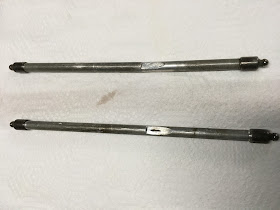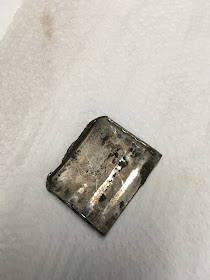Over 13 years of Heinkel ownership I've accumulated a number of engines; people have given then to me, I've found them
in various places, or people have told me about them and I purchased
them. There are a surprising number of engines out there in the USA,
especially considering that maybe only a few hundred total vehicles (almost all
scooters) were “officially” sold here by dealers.
One thing almost every engine has had in common was some type of
major mechanical fault or abuse. Scooter engines tend the have the least
damage; with car engines, each one has a hard luck story.
I present to you a “Heinkel Engine Hall of Shame”. These are some of the best surprises I’ve
come across working on engines, what I suspect happened to them, and what I’ve
done (or will do) to fix them.
We'll start off slow and work our way up:
Example #1
Engine type: 175cc Scooter
Diagnosis: This is your basic "hole in the piston". The
scooter still ran with an obliterated top ring, and no barrel scarring. I guess
that’s why they have multiple rings!
 |
| Heinkel Piston Hole |
Fix: Simple (but not cheap): buy a new oversize cylinder, rings, and barrel.
It was from my first Heinkel scooter:
 |
| Heinkel 103-A2, originally sold in Chicopee Falls, MA |
Example #2:
Engine Type: 200cc car engine:
Diagnosis: Everybody like corn flakes, and in addition to being a
breakfast staple the box can be used as a gasket:
 |
| Brought to you by Kelloggs |
Fix: This was easy. Use a proper gasket!
That weird yellow green mold was a new one on me but came off easily.
Example #3:
Engine Type: 200cc car engine:
Diagnosis: Someone overheated this head,
probably with a torch, until it started to melt. Aluminum starts losing it’s
strength at 600 degrees and distorts at around 800 degrees so my guess is
someone went at this with a torch for some reason (maybe to anneal it and
soften the head for profiling? Who knows)
This engine also came with two heads:
Fix: If this was the only cylinder head
left in the world you could machine it flat and remove the low spots. I left it
as is and put it away.
Example #4:
Engine Type: 200cc car engine:
Diagnosis: Ether someone tried to run a
bigger plug or this is the result of a botched helicoil insert.
 |
| that hole is way too big for a regular plug |
Fix: For as bad as this head looked the
fix was pretty easy; I used one of these, and a regular length spark plug:
The adaptor cost less than the postage to the USA!. Here's a link to the product:
http://www.gsparkplug.com/1x-spark-plug-thread-adaptors-18mm-down-to-14mm-brass-m14-m18.html
Example #5:
Engine Type: 175cc Car Engine
Diagnosis: Mice!
:
Fix: This really could be any old engine
case. If it’s outside in a New England winter something will try to nest in it.
But this engine case was harboring something else even more surprising that
we’ll see in a minute.
Example #6:
Engine Type: 175 or 200cc car engine
Diagnosis: An engine builder’s bodge. I
could see how this happened, but before doing this kind of work you think
they would have asked “maybe I’m doing something wrong?” But no, they went at
these pushrods with a grinder. The
problem here was that they probably trying to use 175cc engine rocker arms on a 200cc engine, or vice versa. They look the same but are different. his person though they would make it “work”
by grinding away at the pushrods.
 |
| What beautiful grinding |
 |
| I'm not sure I can fix them |
Example #7:
Engine Type: 200cc car engine:
Diagnosis: Snowflake shards of metal and
oil that looks like silver nail polish are sure signs of a blown bottom end
crankshaft bearing.
 |
| those snowflakes are busted metal! |
Fix: Send the crankshaft to the Heinkel
Club of Germany (http://www.heinkel-club.de) and get them to rebuild it. The cost is
around 300 Euros. I tried to have this fixed in the USA but could not find
anyone willing to undertake the task.
The same engine had a different (but related) issue. Take a look at this clutch bell. Notice anything missing? If you guessed
a whole section of the clutch side itself, violently separated from the main
clutch bell, then you are correct:
 |
| There's something missing... |
Example #8:
Engine Type: 200cc car engine:
Diagnosis: Attempting to push start a car
that couldn’t possibly go anywhere because the crankshaft was locked up. When you push start a car you are basically
attempting to start the car by spinning the tire, which is not how the car was designed. Depending on the gear you use and the age/ mileage of the engine you are putting tremendous strain on internal components. In this case the
clutch plates took the first hit, in declining order from the main clutch spring.
You can see how the tabs are more progressively worn the closer you get to the
outside of the clutch (where the diaphragm spring is located).
When I took it apart I found the missing
piece at the bottom of the crankcase.
 |
| Clutch bell with missing part |
 |
| The busted piece |
Fix: It was serendipity
that this piece broke away - I was going to weld it back on, but when I saw the
stress cracks throughout the clutch I abandoned that idea. I’ll store this with
the abused cylinder head and fix it only if I’m desperate.
Example #9:
Engine Type: 200cc car engine:
Diagnosis: Stupidity on my part! I can give you the diagnosis because I’m the one that
caused the problem by overreving an engine into a freewheeling state on my test rig. According to my machinist, in an overrev situation the valves usually collide with the piston and trash the top end. In my case the rod bent. I also toasted the bottom bearing. At first
glance nothing looks amiss, until you realize that the connecting rod is
supposed to be straight! This connecting rod bent in two dimensions.
 |
| It doesn't look so bad... |
 |
| A bend to the back (or front) |
 |
| A bend to the left |
This is an example of a bottom end when the bearing has been destroyed:
 |
| Fried bottom end bearing |
Fix: There’s no economically viable fix. Thank goodness for parts engines! I’m going to use a spare crank.
Example #10:
Remember that mousy engine from example 5? It had a mystery that I could only solve after having my bent connecting rod:
Engine Type: 175cc car engine:
Diagnosis: Broken connecting rod smashing through an engine case. I never understood the hole in this engine case:
 |
| Mystery Heinkel Engine Hole |
 |
| It came from the inside! |
 |
| Heinkel Engine Hole |
Fix: None. just a mystery solved. I've been using the engine to mock up the alignment of the new floor I put in my second car.
Well that's enough problems for a lifetime? Do you have any Hall of Shame Candidates? If you do please send them over and I'll post them.





No comments:
Post a Comment